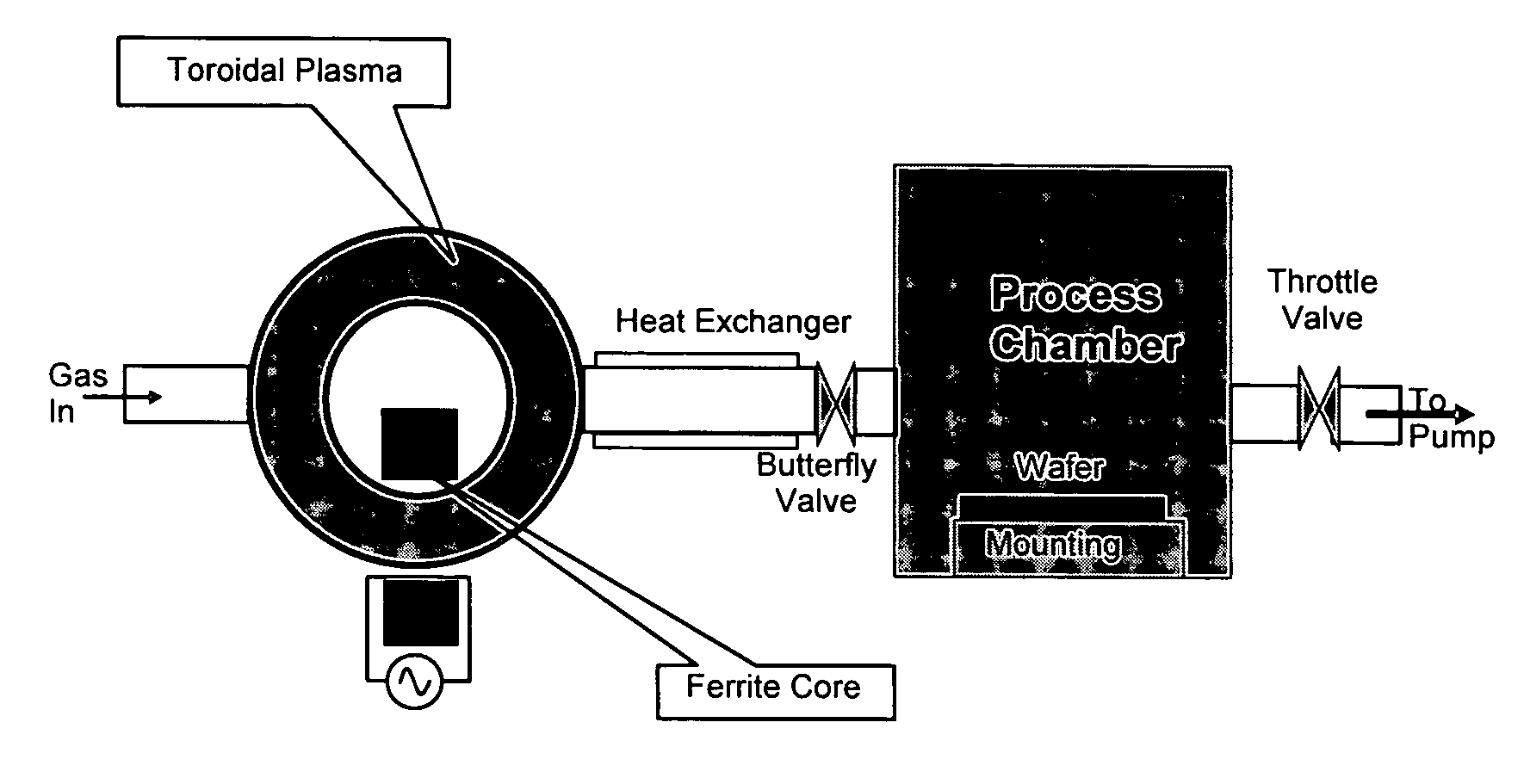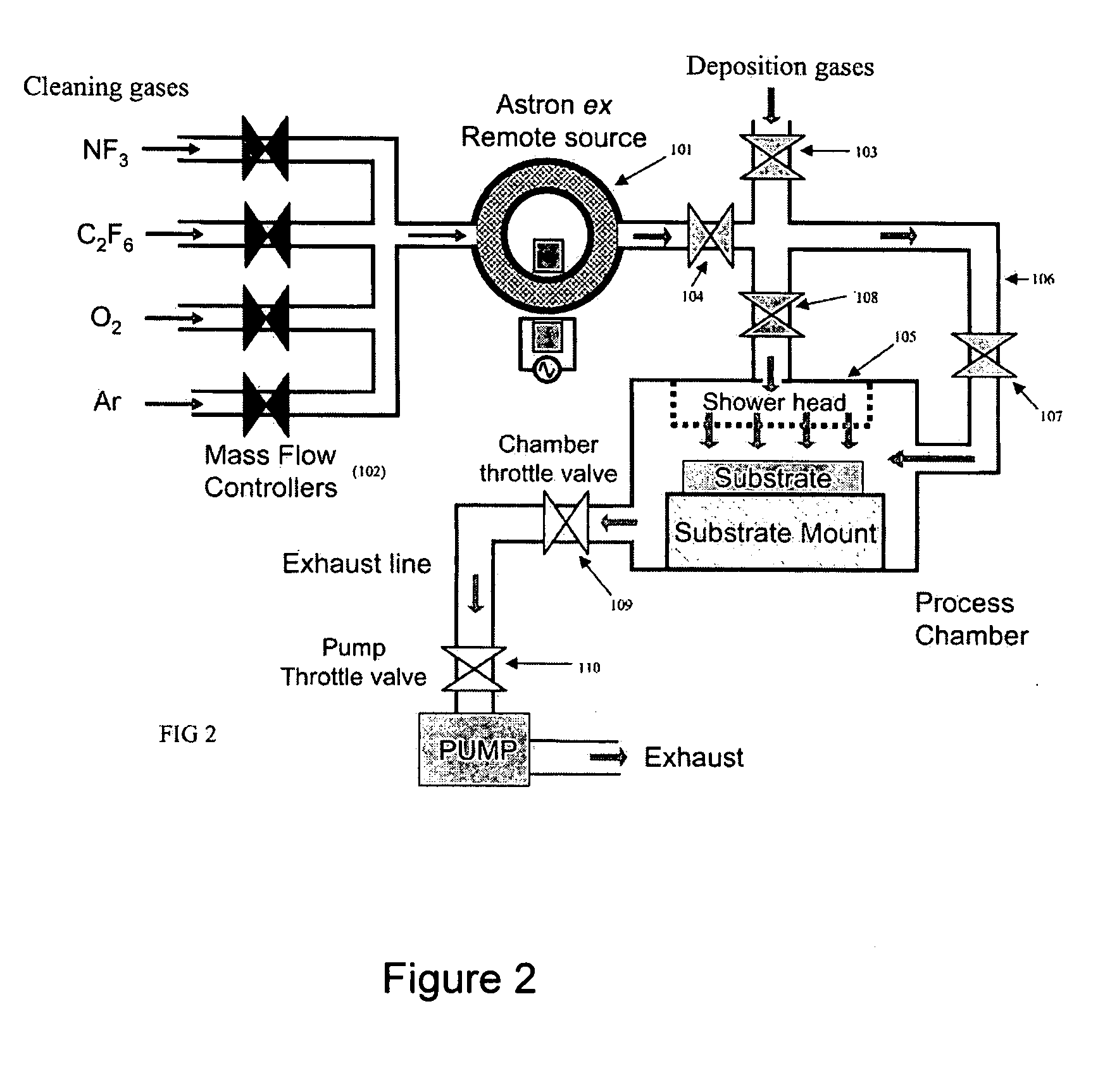Method for removing surface deposits and passivating interior surfaces of the interior of a chemical vapor deposition reactor
a technology of chemical vapor deposition reactor and interior surface, which is applied in the direction of detergent compounding agents, non-surface active detergent compositions, other chemical processes, etc., can solve the problems of reducing the productive capacity of the chamber, the need to clean the chamber regularly, and the effect of cleaning gases being limited
- Summary
- Abstract
- Description
- Claims
- Application Information
AI Technical Summary
Benefits of technology
Problems solved by technology
Method used
Image
Examples
example 1
[0037]This example illustrates the effect of the addition of fluorocarbon on the silicon nitride etch rate in NF3 systems with oxygen at different gas compositions and different wafer temperatures. In this experiment, the feed gas was composed of NF3, oxygen and C2F6. Process chamber pressure was 5 torr. Total gas flow rate was 1700 sccm, with flow rates for the individual gases set proportionally as required for each experiment. By way of illustration, in the experiment with 9% oxygen, 9% C2F6, and 82% NF3, the oxygen flow rate was 150 sccm, the C2F6 flow rate was 150 sccm, and the NF3 flow rate was 1400 sccm. The feeding gas was activated by the 400 kHz 5.9-8.7 kW RF power. The activated gas then entered the process chamber and etched the silicon nitride surface deposits on the mounting with the temperature controlled at 50° C. As shown in FIG. 3, when 3.5 mole percent oxygen and 2.3 mole percent fluorocarbon were added, the etch rate was over 2500 A / min, and exhibited low sensiti...
example 2
[0038]This example illustrated the effect of the addition of fluorocarbon on the silicon nitride etch rate in NF3 systems with oxygen and the reduced effect of source pressure on etch rate. The results are illustrated in FIG. 4. In this experiment, the feed gas was composed of NF3, optionally with O2 and optionally with C2F6. Process chamber pressure was 2 torr. Total gas flow rate was 1700 sccm, with flow rates for the individual gases set proportionally as required for each experiment. By way of illustration, in the experiment with 9% oxygen and 91% NF3, the NF3 flow rate was 1550 sccm and the oxygen flow rate was 150 sccm. The feeding gas was activated by the 400 kHz 5.0˜9.0 kW RF power to a neutral temperature of more than 3000 K. The activated gas then entered the process chamber and etched the silicon nitride surface deposits on the mounting with the temperature controlled at 50° C. As shown in FIG. 3, when 9 mole percent fluorocarbon and 9 mole percent oxygen were added to NF...
example 3
[0039]This example illustrates the effect of the addition of C2F6 on the silicon nitride etch rate in mixtures of NF3 and oxygen with a chamber pressure of 3.0 torr. Total gas flow rate was 1700 sccm. The results are illustrated in FIG. 5. The feeding gas was activated by the 400 kHz 4.6 Kw RF power to a neutral temperature of more than 3000 K. As the results indicate, when 9 mole percent C2F6 is added to the feed gas, i.e. the feed gas mixture was composed of 9 mole percent C2F6, 9 mole percent oxygen and 82 mole percent NF3, the etching rate of silicon nitride increase to from about 2200 A / min to about 2450 A / min, and exhibited lower variation with variations in source pressure.
PUM
| Property | Measurement | Unit |
|---|---|---|
| Fraction | aaaaa | aaaaa |
| Fraction | aaaaa | aaaaa |
| Fraction | aaaaa | aaaaa |
Abstract
Description
Claims
Application Information
 Login to View More
Login to View More - R&D
- Intellectual Property
- Life Sciences
- Materials
- Tech Scout
- Unparalleled Data Quality
- Higher Quality Content
- 60% Fewer Hallucinations
Browse by: Latest US Patents, China's latest patents, Technical Efficacy Thesaurus, Application Domain, Technology Topic, Popular Technical Reports.
© 2025 PatSnap. All rights reserved.Legal|Privacy policy|Modern Slavery Act Transparency Statement|Sitemap|About US| Contact US: help@patsnap.com



